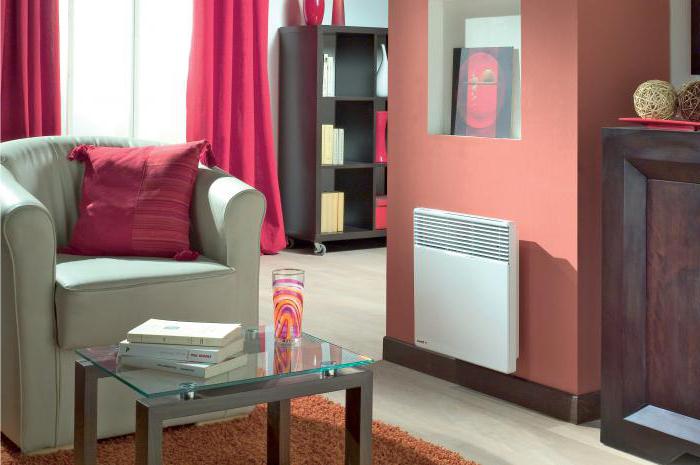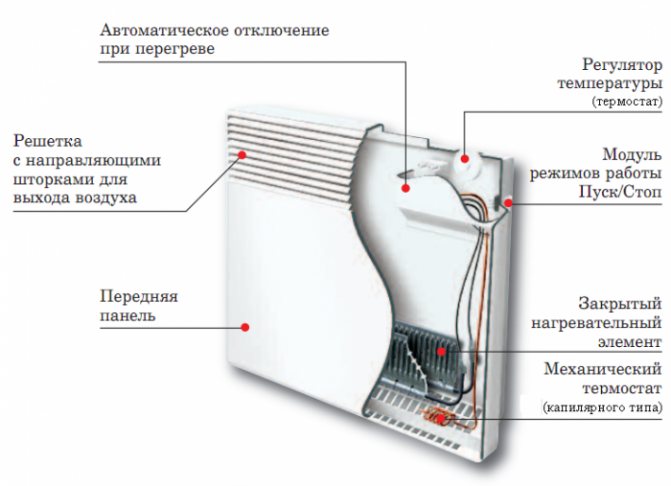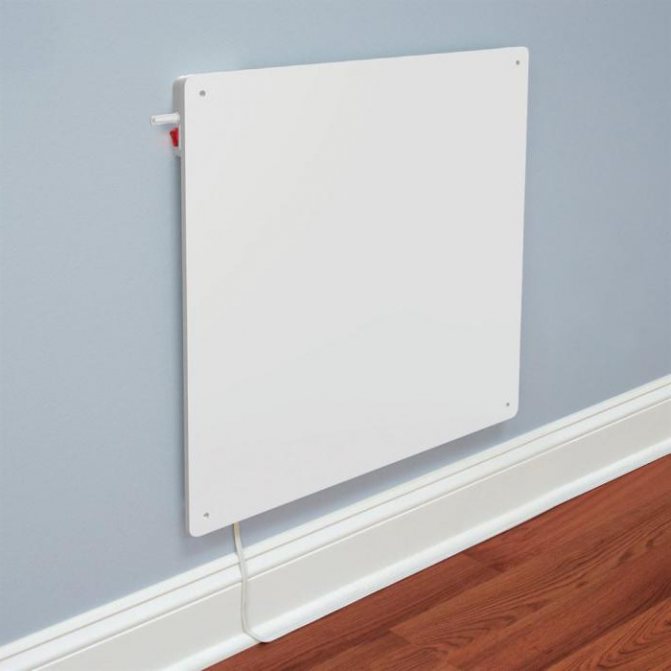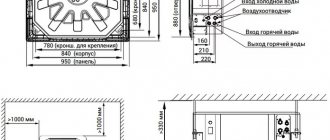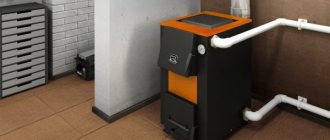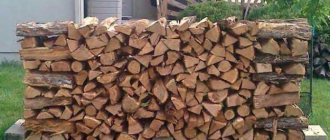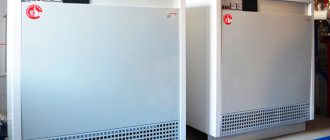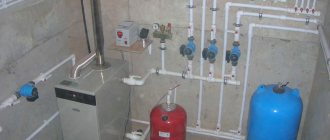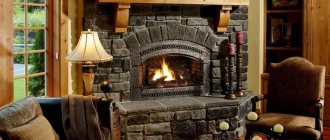To heat the room, you have to use various heaters, but most of all the owners of apartments and houses prefer units that belong to the energy-saving class. This is exactly what a convector-type heater is. In order to draw certain conclusions about this device, it is important not only to get acquainted with all its advantages and disadvantages, but also to carefully study the principle of operation.

What is a convector heater?
If we consider a convector heater in more detail, then we can say what this electrical device consists of:
- First of all, it includes a metal case with special holes.
- There is a heating element inside the case, it is he who heats the air that gets inside.
- Control is carried out using a special unit, which can include both mechanics and electronics.
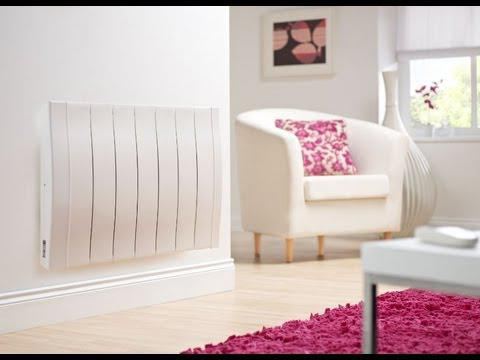

It is very important to remember that the openings are not closed, since it is through them that hot air passes into the room. If you close them, then, most likely, the equipment will fail due to overheating. As a rule, there are no difficulties with the operation of the heating device, it is enough just to adhere to elementary rules. It is simply impossible to answer the question which convector heaters are better, because they are all good in their own way.
Positive aspects of devices and disadvantages
According to customer reviews, the use of devices in home heating has a number of undeniable advantages:
- to start heating activities, it is enough just to buy the device in the store and connect it to the power system, no permits will be required;
- does not require periodic maintenance and repair to maintain it in working condition, the operation of the device is simple and accessible to everyone;
- the devices work quietly and do not disturb the silence, only clicks of automatic mode switching are heard, which are not always audible in terms of volume;
- after turning on the device, the air in the room very quickly picks up the temperature, after half an hour we can already talk about the onset of comfortable conditions;
- according to consumer reviews, significant savings are observed after choosing the optimal heating mode, which is set using modern temperature controllers;
- low purchase price, connection and consumption of the device, in comparison with other types of heating;
- electric convectors with closed heating elements do not dry out the surrounding atmosphere, oxygen in the air is not burned out;
- heating of the elements does not lead to the release of harmful substances and poisonous gases;
- when working in automatic - economical mode, the service life of an electric convector is determined in a couple of decades.
Like any heating device, the electric convector will consume less material for work if you hold high-quality insulation enclosing structures of the house.
Heating with electric convectors has a number of disadvantages:
- Reviews say that with constant intensive heating of the house with convectors, every heating month you have to pay significant amounts for heating.
- The room cools down as quickly as it warms up, which is explained by the low inertness of the device.
- Sometimes it is impossible to connect to a power source in the house due to the low power of the wiring.
- To install the software for a more economical use of the device, the purchase of additional electronic equipment is required.
The principle of using the convector
The heating effect of the convector is carried out by the passage of cold air masses through the heating element to raise the temperature.
The heated air, in accordance with the physical law, rises and mixes with the atmosphere of the room, heats it up. The fan installed in the convector improves the circulation of air masses and speeds up the heating process.
A heating element made of ceramic in a metal case has a high resistance and actively contributes to the temperature rise in the room.
How do convector heaters work?
On the body of the convector heater there are special holes through which cold air enters the heating element, where it heats up and through the upper holes it enters the room. Air circulation takes place in the simplest way, for this you don't even use a fan. Thanks to the thermostat, you can easily set the temperature that is most comfortable for staying in the room.


Such convectors, as a rule, are installed under the window, thus it is possible to obtain a thermal curtain. Some people mistakenly believe that the best convector heaters are more powerful. But this is not so, it is enough to install several convector heaters of lower power, and the room will also be warm - it all depends on the size of the room itself.
Steel convector radiators
Steel convectors are distinguished by a strict, elegant design and have a high heat output that can create effective circulation in any room.
Structurally, steel samples are similar to conventional radiators. A coolant passes inside, heating the body. But, nevertheless, the convective method of heat transfer prevails in them.
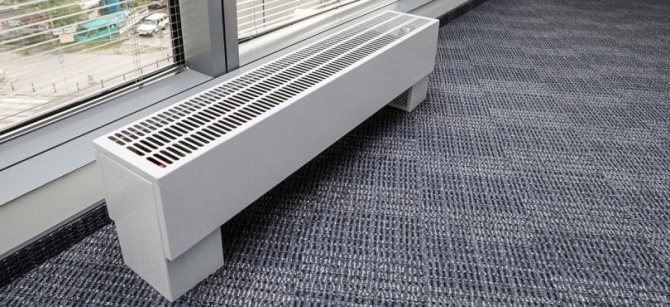

Steel floor convector
Convectors are made of high-alloy low-carbon steel with a thickness of 1.5 - 2 mm and are capable of operating at a pressure in the range of 6 - 10 atmospheres (depending on the parameters of the materials used). This allows them to function both in private houses and in high-rise buildings and withstand a maximum load of up to 9 atmospheres.
The steel convector is not recommended for use in open, steam heating systems where there is a risk of corrosion.
Various modifications are available in a wide range of sizes and shapes. The length parameter can vary from 30 cm to several meters, which allows you to choose the ideal configurations for different rooms. The power at the same length and height of the product may differ due to the use of different types of convective finning.
To minimize heat loss, the back wall of more expensive products is made of a plate with a very low thermal conductivity coefficient. Such a plate (or screen) practically does not allow heat to pass through, and prevents the radiator from aimlessly heating the window, and through it the street.
What types of convectors are there?
Convector heaters are divided into several types:
- Electrical. They are the most affordable and easy to install and operate, while it should be noted that the main advantage is their low cost. Of course, installing such a heater in a large house is not worth it, as the cost of electricity will be high.
- Water heaters work with water. They can be hung on the wall, installed above the floor, hence their name - floor. Due to their low weight, they can be installed in any convenient place, for example, even on a plasterboard wall. The cost of such units is not high, in most cases it all depends on the model.
- Consider gas convector heaters. The pros and cons of these units need to be studied in more detail, since they are the ones in greatest demand. First of all, it should be noted that with such a heater you can save a lot, since gas is an economical fuel, and the convector itself can replace the batteries in the room. The disadvantage of the equipment can be considered the obligatory presence of a chimney, this is important for the safe operation of the heater.
- The most recent type is a film heater, which has been used not so long ago. Such a heater is a film that is equipped with special heating elements. The advantage of such a unit is its ease of use, it can be easily mounted on the wall, easily folded up and removed.
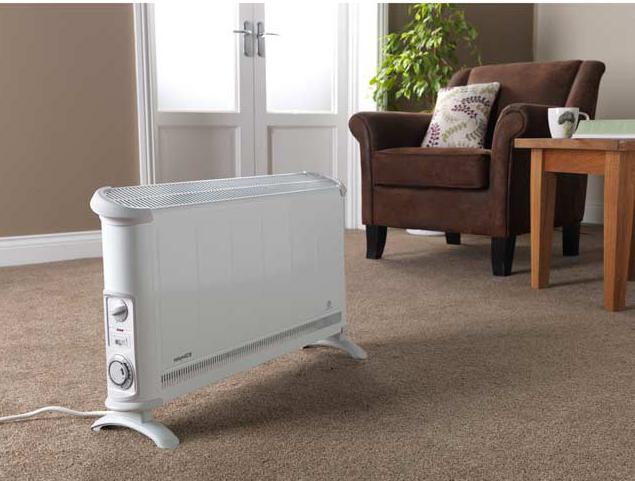

As you can see, all convector heaters have different pros and cons. They must be studied carefully before purchasing this equipment.
Features of the convector heating system
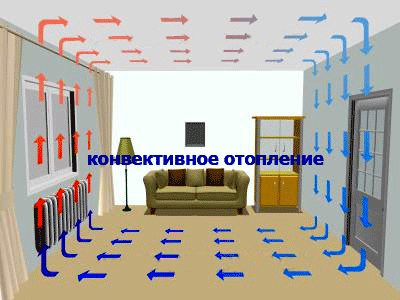

The principle of operation of convector heating
The very first convector heating radiators are traditional stoves. Thermal energy from their surface is transferred to the room. In this case, natural convection of air flows occurs - with a higher temperature they rise up, creating a circulation of heat.
However, the efficiency of their work remains extremely low - the efficiency indicator did not exceed 25-30%. Therefore, convector heating boilers have been developed that transfer energy more efficiently. To do this, their design provides for additional convector surfaces that improve circulation, and, accordingly, the heating rate of the house.
What is the difference between convection heating at home and the usual one?
- Lack of pipelines. This reduces the primary cost of organizing heating;
- The ability to install local heating points - autonomous radiators. Most often this is done for summer cottages or houses with a small area, or apartments;
- Prompt regulation of energy consumption to optimize the temperature regime.
The disadvantages of such a system include the complexity of the organization for buildings with a large area. Even having installed convector water heating, consisting of autonomous radiators, it is problematic to make a single control unit. But there are exceptions - modern gas convection heating boilers. These are common models that can be installed in piping systems. The parameters for choosing such boilers are the same as when designing a traditional type of heating.
The amount of energy generated in convector-type heaters directly depends on the area of the heat exchanger. This is what you need to pay attention to first of all.
What to look for when choosing a convector?
Initially, it is necessary to clearly define the type of convector that will be used in the room. As a rule, the energy with which it will work is taken into account. For example, it is wrong to purchase a gas heater if there is no connection to this communication. Next, you need to pay attention to the power, if the room is well insulated, then it is enough to purchase a convector with a low power.
Many people buy convector heaters. The pros and cons in the operation of these units largely depend on the manufacturer, so it is best not to experiment, but to opt for companies that have long been known for their climatic technology. By following these simple guidelines, you can purchase a reliable, functional and durable product.
The type of installation is also important. For example, in some rooms it is better to install wall or floor convectors. It is worth paying special attention to additional options, this includes a timer, remote control and a security system.
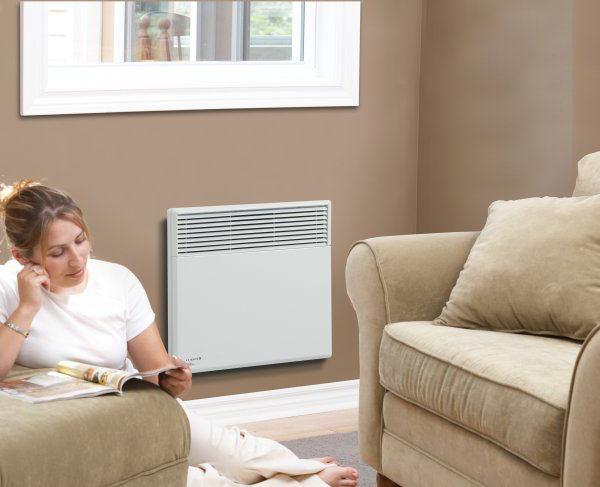

Convector heating battery
Modern convector radiators - the principle of operation and classification by type
The problem of heating housing in our country can be solved in different ways. In the days of severe winter, an integrated approach to organizing a comfortable microclimate is most often used. And convector radiators play an important role here.
How do they work, and what types of similar heating devices are there?
What is a convector, how does convector heating work?
From a technical point of view, a convector is an ordinary pipe to which a large number of plates are attached. A coolant enters the pipe, heating the plates along the way. Air runs between them, which, when heated, rises up to the ceiling. There it cools down, goes down and, passing through the plates, rises up again. It is the constant circulation that allows you to organize quite effective heating.
The design of the convector is as follows. The body is a steel or copper tube. It can withstand a water pressure of 25 atmospheres. Plates are attached to the pipe by welding, for the manufacture of which low-carbon steel is most often used.
The size of the plates and the dimensions of the installation are calculated taking into account the area of a particular room. Sometimes a baffle is used to increase the efficiency of the convector. It covers only part of the installation, but this is enough to increase the efficiency of the device.
Depending on how the air is circulated in the room, convectors are divided into models with natural and forced circulation. In the second case, the installation is completed with a small fan. The main advantage of this choice is the high speed of heating the room.
Convector classification
Converter heating is based on the obligatory use of some kind of heat carrier. Depending on what is used as it, there are 3 types of heating systems:
Water convectors
There are both advantages and disadvantages to using water-based options. Wall-mounted, floor-standing and built-in models allow you to organize heating of any room, large and small. To create such heating devices, stainless steel is used, which is distinguished by high resistance to corrosion, good fire-fighting characteristics and ease of installation.
Pleasant appearance, low weight of products, compactness of installations and quiet operation - all this can be included in the list of significant advantages of water convectors.
But in fairness, it is necessary to list their shortcomings:
- When the air circulates to the ceiling, dust always rises, making the life of allergy sufferers unbearable.
- It makes no sense to use water convectors where the ceilings are higher than three meters. They will not have time to warm up the room. Most of the heat will accumulate at the top and the floor will remain cool. A person perceives such discomfort badly.
- The movement of air masses is always a draft. And if small children grow up in the house, or elderly people with weak immunity live, then colds will settle there for a long time.
- Water convectors cannot be used in conjunction with ventilation units. In this case, all the heated air will be discharged outside, and the heating effect will be reduced to zero.
Note! Despite such significant shortcomings, water-type convectors constitute a worthy alternative to conventional radiators.
Gas type convectors
A gas convector is an autonomous heater, the principle of which is extremely simple. It is similar to the operation of a recuperative heat exchanger. The gas heats up the metal plates, which give off their heat to the room.Gas combustion products are discharged outside by means of a chimney due to the presence of natural or forced draft.
The positive aspects include the ease of installation and versatility of the device. The device can be mounted in any room. On sale there are models of various designs, sizes and colors. Therefore, it is easy to find a heating device that fits perfectly into the interior concept.
During installation, you do not need to take into account the location of the heating wiring and its slope, as well as build complex connection diagrams. The gas convector can be installed in any convenient place and is used as a main or additional heating source. The efficiency of such an installation is slightly higher than the efficiency of a gas boiler of the latest generation. And this is the main advantage of choosing.
Despite such a large number of positive aspects, gas convectors have disadvantages.
Cons of gas convectors
- The main disadvantage is that one device is capable of heating only one room or a single room. To heat the whole house, you will have to buy several gas convectors, which is not a cheap pleasure.
- Such a device cannot be used to organize the supply of hot water. And in this, gas convectors lose to double-circuit gas boilers, which are often used to organize water heating.
- The capacity of the plant is limited by its size. The smaller the appliance, the less heat it produces.
- Sometimes it is necessary to disguise the heating device. In the case of a gas convector, this will not be possible. You cannot cover the device with anything.
- A permit is required for the installation of gas convectors. Installation can only be carried out by firms and companies licensed to work of this type.
Note! Each gas convector has a different power, and inside a cast iron or steel heat exchanger can be used. A cast iron heat exchanger is more reliable and durable.
Electric models
Electric convectors Beta series
Conventional electric convectors also have a fairly simple design. Their central element is a heating element, which is housed in a steel case. In the upper and lower parts of the latter there are slots through which air masses circulate freely.
All existing models are divided into two large groups - floor and wall. Floor convectors are mobile and can be installed in any place convenient for you. Wall mounted are mounted in the same place as conventional water radiators, that is, under the window sill by the window. They act as a curtain against the cold.
What operational benefits can you expect when choosing electric convectors?
- Installation of the installation is extremely simple - you bought it, brought it home, put it or hung it up in a chosen place, connected the plug to the outlet, and you can use the device. It provides instant heating of the air.
- Electric convectors are cheaper than water and gas models. Reliable automation, which is equipped with almost all modern electric radiators, protects the device from overheating, ensuring safe use. It also controls the heating temperature, so you can independently adjust it using intuitive controls.
- There are no moving technical units inside the body, so the units operate completely silently.
- The efficiency of such installations is very high and amounts to 95%.
There is only one drawback of electric type radiators - they need electricity to work. Today it is the most expensive type of fuel.
Generalization on the topic
Heating convectors are designed to heat one room. Special requirements apply to them.Almost all convector radiators must be affordable, meet sanitary and hygienic requirements, have high mechanical strength and demonstrate reliability and safety of operation.
How to choose convector heating at home: reviews, batteries, radiators
The operation of any heating system is based on one or another method of transferring thermal energy from the energy carrier to the air in the room. For this, various types of fuel are used - gas, coal, firewood, etc. But is it necessary to do the installation of pipelines. In the absence of such an opportunity, they equip convector heating at home: reviews, batteries, radiators. This is not a new method of heating the air in the home. But this needs to be told in more detail.
Features of the convector heating system
The principle of operation of convector heating
The very first convector heating radiators are traditional stoves. Thermal energy from their surface is transferred to the room. In this case, natural convection of air flows occurs - with a higher temperature they rise up, creating a circulation of heat.
However, the efficiency of their work remains extremely low - the efficiency indicator did not exceed 25-30%. Therefore, convector heating boilers have been developed that transfer energy more efficiently. To do this, their design provides for additional convector surfaces that improve circulation, and, accordingly, the heating rate of the house.
What is the difference between convection heating at home and the usual one?
- Lack of pipelines. This reduces the primary cost of organizing heating;
- The ability to install local heating points - autonomous radiators. Most often this is done for summer cottages or houses with a small area, or apartments;
- Prompt regulation of energy consumption to optimize the temperature regime.
The disadvantages of such a system include the complexity of the organization for buildings with a large area. Even having installed convector water heating, consisting of autonomous radiators, it is problematic to make a single control unit. But there are exceptions - modern gas convection heating boilers. These are common models that can be installed in piping systems. The parameters for choosing such boilers are the same as when designing a traditional type of heating.
The amount of energy generated in convector-type heaters directly depends on the area of the heat exchanger. This is what you need to pay attention to first of all.
Converter boilers
Installation of convector-type boilers is relevant only if it is necessary to maintain a comfortable temperature in a small room - up to 20-30 m². When choosing a particular model, you need to pay attention to its body - it must have additional panels or pipes through which air passes. The more efficient the convector heating system is, the greater the volume of air will pass through these structures.
Solid fuel heating boilers
One of the most popular overhead convection boilers at the present time are the Bulleryan ovens. They consist of a cylindrical body, on the outside of which convection pipes run.
Combustion, solid fuel transfers the maximum amount of warm energy to the walls of the structure. This leads to heating of the air in the pipes, as a result of which its circulation begins. There are two ways to regulate the temperature - by reducing the volume of the fuel filling or by reducing the air flow through the ash pan.
However, it is not always possible to install this boiler in a residential area. Analyzing reviews about convector heating, where it is the main element, one significant drawback can be identified - large dimensions. For industrial or technical buildings, it will be optimal, since dimensions in this case are not the main priority when choosing.If this is important, you can install a convector electric heating. It is more expensive, but at the same time the radiators are much smaller.
To select a suitable boiler model, you need to pay attention to the following parameters:
- Its rated power... kW. It should be borne in mind that manufacturers give maximum performance;
- Dimensions (edit)... In addition to the size of the structure, you will need a place for its installation. The most efficient operation of a convection heating boiler will be in the absence of obstacles on the sides. Those. air must pass freely through the pipes;
- The weight... The average weight for the 18 kW model is 130 kg.
The cost of a convection heater directly depends on its power. The table shows the average prices for Russian-made Bulleryan boilers.
According to the reviews of the owners of the converter heating, one fuel tab is enough for an average of 8 hours of continuous operation. The minimum metal thickness of the boiler drum must be 1.5 mm. The best option is cast iron. However, the cost of such models is 50-70% more expensive than steel ones.
Gas heating boilers
Convection gas boiler design
Gas convection heating boilers are installed for systems in which pipelines are provided. They do not provide heating of the air, but transfer the energy of gas combustion to the coolant - water in the pipes.
A feature of convector water heating is the use of an intermediate medium (heat carrier) for heating the air. In this case, the boiler drum is not a heat source. Therefore, the dimensions and weight of the structure are much less than those of Bulleryan ovens or similar ones.
The specifics of the organization of such a system are as follows:
- Mandatory installation of highways in all premises;
- Choice of models with 2 heat exchangers. One of them is intended for hot water supply;
- Registration of permits before connecting to the gas main.
However, the installation of such a boiler has a number of advantages. One of them is the duration of the autonomous operation of convector heating at home. In most cases, the control unit provides several modes, as well as the ability to connect to external temperature sensors for automatic regulation of the boiler power.
The cost of gas boilers is affected by their equipment. Models with a circulation pump and expansion tank have a higher price.
Radiators and gas convectors
If point heating devices are sufficient to maintain the temperature in the room, it is recommended to install gas or electric convector-type heating. They consist of a heating element, a control unit and a combustion products evacuation system (gas models).
Electric heating convectors
Electric convector design
This is the easiest and fastest way to make heating in a house or apartment. An electric heating element serves as a heating element, the temperature of which is transferred to the body of the device. With the help of a system of slots, air freely penetrates into the inside of the radiator, creating convection.
The most common models for a convector heating system have a tubular heating element with metal plates. This increases the heating area. But the reviews speak of one drawback - during operation, extraneous sounds are heard. The reason for this is the expansion of the metal of the plates.
To install convector heating batteries, the following conditions must be met:
- The cross-section of the wiring must be designed for the maximum power of the device;
- It is recommended to install a separate RCD to prevent short circuits;
- According to safety rules, the convector must not be left on when there are no people in the house.
You also need to take into account the high energy costs.Therefore, in the presence of a gas main, convector heating batteries with a burner are chosen.
The cost of electric convectors ranges from 4000 to 15000 rubles. It is important to pay attention to the characteristics of the control unit, protection against water and the presence of an automatic shutdown when overturning.
Gas convectors heating
Economical heating of a convector-type house can be done by installing gas models. They consist of a burner that is not located indoors. Air supply and combustion products are removed through a coaxial chimney.
Unlike convectors for electric heating, gas models are large in size. This is due to the presence of a gas burner and a sufficiently large heat exchanger. To improve convection, a fan is installed in some models to increase air exchange.
The average cost of gas convectors is 8000-12000 thousand rubles. Despite the large number of foreign brands, they prefer to purchase domestic counterparts. They are better adapted to specific operating conditions.
In what cases is the installation of convector heating at home justified. Reviews about him, the high cost of batteries and radiators indicate a balanced approach when choosing such a system. In most cases, it is relevant for small rooms and production workshops, where it is necessary to make zonal (selective) heating.
In the video, you can familiarize yourself with the features of the installation of gas convectors:
Convector battery: design, characteristics, pros and cons
October 27, 2016
With the onset of cold weather, many families have to think about additional heating devices. There are a great many of them today. Centralized heating sometimes simply does not cope with the functions assigned to it, and in remote areas it may not have been carried out at all. In this case, a convector battery would be a good solution to the problem.
The convection principle is used in many devices. It allows you to heat the room very quickly. Therefore, it will be interesting for almost everyone to learn about convector batteries.
Convection principle
Convector radiators operate on various energy sources. But the principle of their action is the same. The air heated by the convector rises up, and the cold masses go down. The same process takes place in nature. At the same time, cyclones and winds are formed.
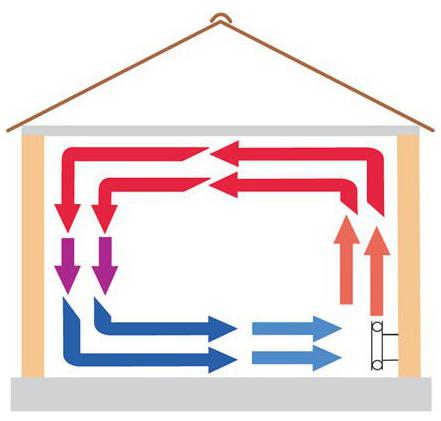

Heated currents of air rush to the ceiling in the room, as they are lighter. Cold masses are determined at the floor. This movement occurs naturally. Some devices provide additional ventilation, which speeds up heat exchange processes.
But a conventional convector battery independently circulates air masses in the room. This is a simple but reliable way to heat your home quickly and with minimal energy consumption.
Convector device
Convector radiators are characterized by a simple design. These devices consist of two main parts - a heating element and a body of a certain shape.
There are special openings at the bottom of the device for extracting cold air. Warm masses come out through the top of the convector. There are also special departments here. The heating element is inside. It is installed at the bottom of the system.


The air inside the housing is heated. The convector sends it up. Cold streams rush down. To improve the circulation of air masses in the room, the air outlet holes are located at a slight slope. This allows the heated stream to be released further into the room.
When the air cools down, it gradually sinks to the floor. This is how the circulation of air masses occurs in the room.
Types of structures
There are several types of convectors. First of all, they are grouped according to the energy carrier used. In this case, a distinction is made between electric, gas and water convectors. Each of them has its own pros and cons. The most popular today is an electric wall-mounted heating convector. Therefore, he should pay more attention.


Electric convectors differ in the design of the heating element. They can be tubular, monolithic, or needle-like. In the latter case, the heating element is made in the form of a thin plate on which a chromium-nickel thread is installed. This material instantly heats up and cools down. This is one of the cheapest types of electric convectors. They cannot be used in damp rooms.
A tubular heating element (TEN) is a steel device in which a nichrome thread is installed. It is surrounded by a special heat-conducting substance. This is a fairly durable type of device.
Monolithic heating elements work silently. Their body is characterized as one-piece. These devices are considered to be the most efficient.
Features of electric convectors
Electric wall-mounted or floor-standing heating convectors are very popular today. It is easy to operate and has high heating efficiency. At the same time, energy costs are minimal. This is due to the well-thought-out system of electricity consumption during the operation of the convector.


Many manufacturers equip their heaters with a control unit or programmer. The programmable control unit allows the convector to remain off when the owners are, for example, at work. This significantly saves the family budget.
In order for convector heating radiators of the presented type to work for a long time and safely, when buying, you must give preference to proven brands.
Advantages and disadvantages of an electric convector
A convector heating battery has a number of advantages, but it also has disadvantages. This must be taken into account when choosing equipment. The advantages of the presented type of devices include operational safety. The surface of the case does not heat up above 60 ° C, so it is impossible to accidentally get burned from contact with the battery.
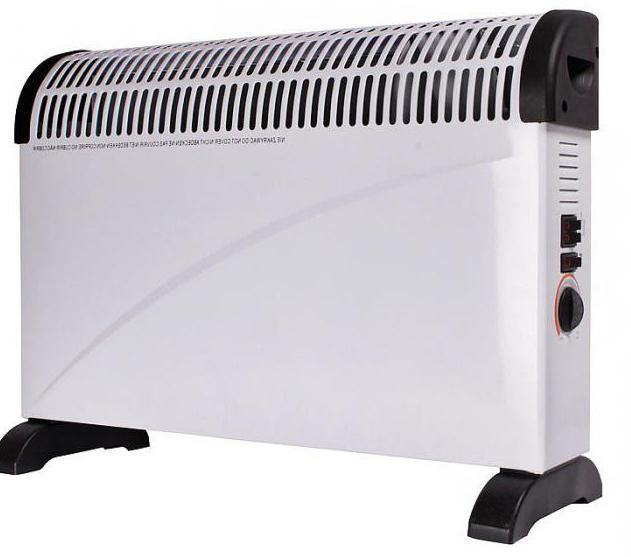

The efficiency of the presented convectors reaches 95%, and this, in turn, speaks of savings in energy costs. These devices are easy to operate, their operation is usually very quiet (if the model does not have a fan).
The disadvantages include a gradual decrease in efficiency during the operation of the equipment. Because of this, energy costs will increase. An electric convector heats a room of a certain area. To heat the whole apartment, it is necessary to install such a device in every room.
But, despite the shortcomings, it is this type of heating that is highly popular among the inhabitants of our country. It is used as an addition to the main heating.
Advantages and disadvantages of gas convectors
The convector type battery can also be heated with gas. The principle of operation of such equipment is similar to electrical varieties. But the heat exchanger is heated with gas. To install such equipment, you must have certain knowledge.
The gas convector is connected to the main line using a hose. This heating option will be cheaper. But when using liquefied gas, energy costs will be comparable to electrical equipment.
The advantages of gas heaters include operational safety and high efficiency. Even in severe frost, this device fully copes with the functions assigned to it.The disadvantages include the complexity of installation, the need to install a coaxial pipe.
Advantages and disadvantages of water convectors
Convector radiators can use water as a heat carrier. This is the cheapest type of heating. It is connected to the central heating system. Convectors of this type have many advantages over conventional batteries.
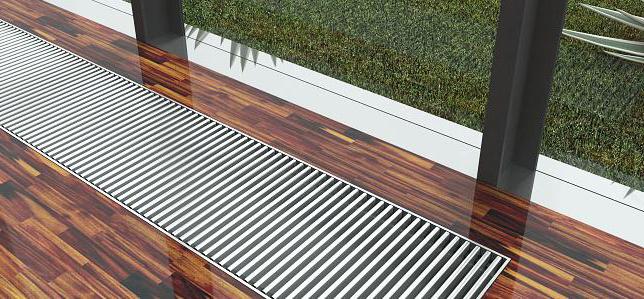

Thanks to the installation of shut-off valves, this equipment is very easy to operate. The hot water convector heats up quickly. It is safe to use, there will be no burn from contact with the case.
The disadvantages include insufficient efficiency in large rooms or in rooms with high ceilings. Drafts can occur if the air flow is unevenly distributed.
Manufacturers overview
A convector battery, the price of which depends on many factors, can cost in the range from 2 to 20 thousand rubles. The simplest types of electric batteries have a minimum set of functions. Their cost is from 2 thousand rubles. But among all the variety of models presented, experts advise choosing electric convectors with TEN or monoblock. Devices of the brands Electrolux, Polaris, Ensto have proven themselves well.
A gas convector will cost more. Its cost is from 13 thousand rubles. The most famous manufacturers of this type of equipment are Karma, ATON, Gorenje. Reviews of these manufacturers are more positive.
It should also be noted that the cost of the convector depends on the principle of its installation. Floor-standing and wall-mounted models will cost significantly less than built-in equipment.
Expert advice
The convector battery is selected taking into account the room conditions. All the presented types of devices have different heat transfer. But in general terms, you can calculate the required power. If the ceilings in the room are of standard height (do not exceed 2.7 m), 1 kW is required for every 10 m² of area. In corner, basement rooms, this figure increases.
Experts advise installing a convector under each window. If the ceilings are high, the power of the convector must be increased. If the heater will only be used in a specific room, it can be wall-mounted. To be able to move the convector between rooms, the technician must have wheels and stands in the set.
Having considered what a convector battery is, what kinds of it there are, you can choose the best option for a heating device. Taking into account all the advantages and disadvantages, it will be easy to acquire a durable and efficient heater.
How does it feel to be heir to the royal throne? 7 Surprising Facts Royal heirs are entitled to a number of benefits, but until recently they were also limited by ancient traditions formed for the last time.
How to inform your daughter or son that there will be another child in the family Are you expecting another child? Congratulations! You probably want to share this joy with family and friends, but what about older kids? When.
What you need to consider when choosing a summer camp for your child The academic year has just ended, which means it's time to think about which camp your children will be resting in this summer. You should start exploring.
Why do you need a tiny pocket on jeans? Everyone knows that there is a tiny pocket on jeans, but few have thought about why it might be needed. It is interesting that originally it was a place for the Chr.
How to look younger: the best haircuts for those over 30, 40, 50, 60 Girls in their 20s do not worry about the shape and length of their hairstyles. It seems that youth is created for experiments on appearance and daring curls. However, already the last.
Our ancestors slept differently from us.What are we doing wrong? It's hard to believe, but scientists and many historians are inclined to believe that modern man sleeps quite differently from his ancient ancestors. Initially.
- The heating battery is noisy. What to do? This heating season I faced such a problem that a battery is making noise in one of the rooms ...
- Heating system of a one-story house The device of the heating system is one of the main points that should be taken into account when building any residential building. ...
- Economical electric heating boilers The ever-increasing rise in energy prices makes our compatriots look closely at the new modern trends that are outlined ...
- Choosing steam heating batteries Equipping with steam heating is an integral part not only in the construction of new buildings, but also in the reconstruction ...
What are the main advantages of using convection equipment?
Users prefer convector heaters. The advantages of such a purchase are obvious:
- First of all, it is worth highlighting the noiselessness of the equipment. Since there is no ventilation, the heater works silently.
- There are no problems with the choice of the unit, as there is a huge range of equipment on the market today.
- The convector heater will perfectly fit into any interior and will not spoil its aesthetic appearance.
- The air that enters the convector simply heats up, while oxygen is not burned, which is important for living indoors.
- The service life is quite long, so we can safely talk about durability. The minimum service life is 10 years.
- Heaters are considered one of the safest in operation; for this, a special protective system is installed in the units, which does not allow the equipment to heat up over 60 degrees.
- The cost of a convector heater of any kind is affordable, so almost every resident with an average income can afford such a purchase.
Reviews of convectors from the point of view of the heating element
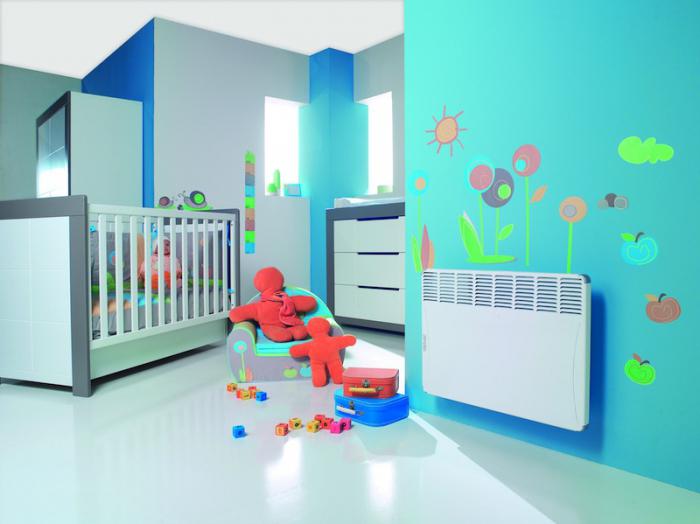

An electric heating convector for a private house can have a different heating element, so it should be highlighted:
- monolithic;
- tubular;
- needle-like.
The second type of heating elements has aluminum fins. Needle ones are a thin dielectric plate on which a chromium-nickel heating thread is installed. It is covered with an insulating varnish. According to buyers, devices with such heating elements cool and heat up almost instantly. Convection in such devices is created on the basis of a needle heater and is carried out due to the design of the case. Due to the fact that the varnished thread is almost not protected from moisture, the operation of equipment with such a heating element in damp rooms is not recommended. According to buyers, the main advantage of such devices is cost, but the durability of the device is questionable. In practice, needle heating elements are rarely used, but if during the selection process you come across such a unit, then it is best to pass by.
Wall-mounted electric convectors can have tubular heating elements, which are steel tubes with nichrome thread. According to consumers, efficient heat transfer is provided by aluminum fins, which enhances convection. Such elements heat up less than needle elements, but are more durable. Many units with such heating elements are made in a splash-proof design and can even be used in bathrooms. Consumers note that such equipment also has its drawbacks, which are expressed in sounds resembling crackling, arising from the difference in thermal expansion of the ribs and tubes during the operation of the device.
If you are interested in electric convectors for home heating, but you do not want to put up with noise, then consumers advise you to choose monolithic heating elements, the body of which is one-piece. Ribs are an integral part. Buyers note that such devices work with the least heat loss, therefore they are highly efficient. Quite often, experts advise stopping the choice on electric convectors, which work by means of tubular or monolithic heating elements. The latter would be ideal.
Disadvantages of convector heaters
Despite the huge number of advantages, it is worth paying attention to the disadvantages of convector heaters.
- Since the equipment does not have ventilation, the room will warm up slowly.
- The heater requires constant maintenance as it needs to be cleaned of dust.
- In the event of a breakdown, you will have to pay dearly for repairs.
- The use of electric convectors may not always be beneficial, since the energy consumption will be too high to heat a large room.
- Electronic control cannot always live up to expectations, since sometimes it gets lost and needs to be reconfigured.
Advantages and disadvantages
A modern water heating convector is considered an effective option, but it has one main drawback - it cools down quickly. Therefore, in winter, it is necessary to constantly maintain the supply of hot coolant if a local boiler is installed in the house. First of all, it is worth touching on the advantages:
- The possibility of creating thermal curtains in front of panoramic windows, which in winter time excludes the formation of condensation.
- Effective heating of rooms of all sizes.
- Low weight allows you to install hot water convection radiators on plasterboard panels.
- Models are built into the floor if required.
- Full compliance with modern fire safety requirements, since the heating element is placed in a special case.
- Large selection of types and sizes, each with a unique design.
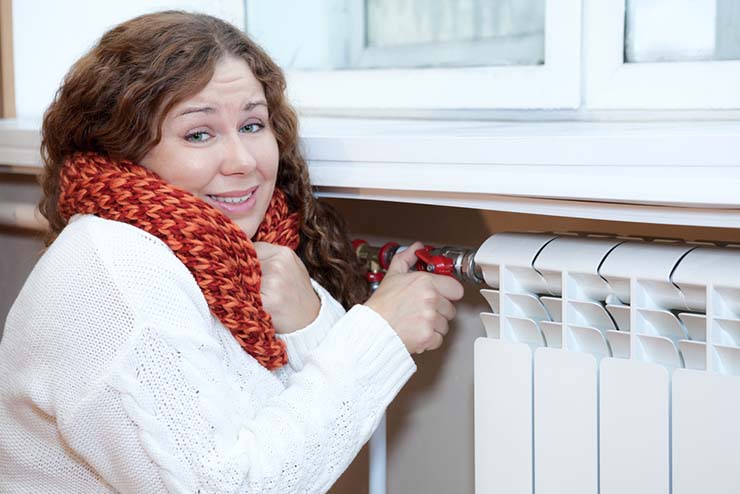

Radiators, in addition to a large number of pluses, have a few minuses, for example, large size
The disadvantages are minimal, and they are all related to the size and dimensions of equipment and premises. One can hope for high efficiency, the installation of auxiliary fans, but the disadvantages remain. Main disadvantages:
- Impossibility of heating rooms with high ceilings. Very often it is necessary to install several convectors with forced air supply.
- The cost is higher than that of standard radiators.
- Large dimensions.
The last point is leveled by the ability to install the equipment on the floor. Each model is unique in its own way and has its own technical characteristics. When buying, it is recommended to take into account the possibility of using the convector in a particular room. To do this, you need to indicate the area and height of the ceilings in the room, based on this, the consultant will select the appropriate option.
Installation of wall convectors:
Comparison of convector heaters with other types
Before choosing a convector or oil heater, it is important to study the pros and cons of all types of this equipment in more detail. Among the climatic equipment, an oil cooler is also considered common. Due to its availability and quiet operation, such a unit is in great demand. But we must remember that an oil heater dries the air greatly, burns out all the oxygen in the room, because the heating depends on the heating of the case. Some people choose a fan heater, but it is very noisy, accumulates a lot of dust and requires constant cleaning.
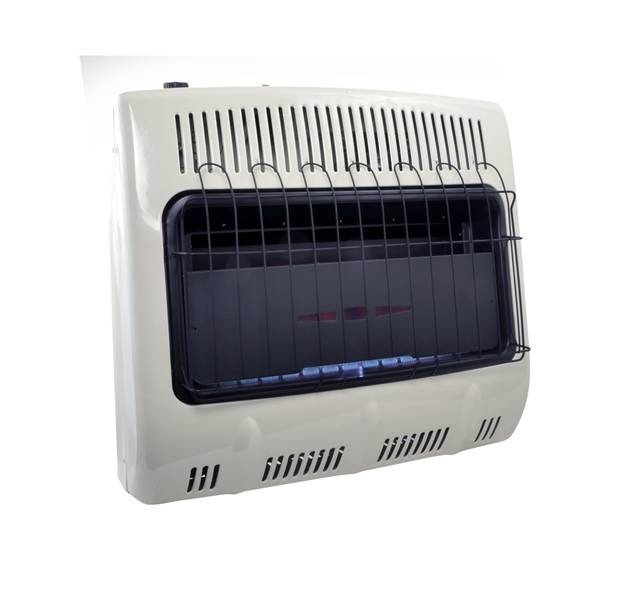

A heater that works using infrared radiation can compete with convection equipment.But the cost of such equipment is too high.
Why choose a convector
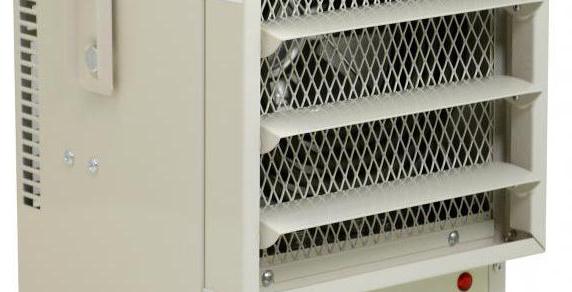

The air temperature will depend on the power of the convector and sometimes reaches a limit of 100 ° C. Electric convectors for heating a private house, reviews of which you can read in the article, are environmentally friendly, because the dust does not burn on the surface of the device with slight heating, therefore the device meets all fire safety requirements.
Which heater to choose for heating in the house?
We examined convector heaters, the advantages and disadvantages of this equipment. Now it is worth paying attention to the calculations that will help you choose the right heater for the area of the room. It is very important for a small room to choose a convector with a low power, if the room is large, then it is better to opt for more powerful equipment. For a children's room, it is necessary to choose a convector, since only with the help of it it will be possible to maintain a constant temperature and humidity, which is important for the child's health. The equipment can be used not only in rooms, it is ideal for use on loggias.
Converter boilers
The installation of convector-type boilers is relevant only if it is necessary to maintain a comfortable temperature in a small room - up to 20-30 m². When choosing a particular model, you need to pay attention to its body - it must have additional panels or pipes through which air passes. The more efficient the convector heating system is, the greater the volume of air will pass through these structures.
Solid fuel heating boilers


Bulleryan boiler
One of the most popular overhead convection boilers at the present time are the Bulleryan ovens. They consist of a cylindrical body, on the outside of which convection pipes run.
Combustion, solid fuel transfers the maximum amount of warm energy to the walls of the structure. This leads to heating of the air in the pipes, as a result of which its circulation begins. There are two ways to regulate the temperature - by reducing the volume of the fuel filling or by reducing the air flow through the ash pan.
However, it is not always possible to install this boiler in a residential area. Analyzing reviews of convector heating, where it is the main element, one significant drawback can be identified - large dimensions. For industrial or technical buildings, it will be optimal, since dimensions in this case are not the main priority when choosing. If this is important, you can install a convector electric heating. It is more expensive, but at the same time the radiators are much smaller.
To select a suitable boiler model, you need to pay attention to the following parameters:
- Its rated power, kW. It should be borne in mind that manufacturers give maximum performance;
- Dimensions (edit)... In addition to the size of the structure, you will need a place for its installation. The most efficient operation of a convection heating boiler will be in the absence of obstacles on the sides. Those. air must pass freely through the pipes;
- The weight... The average weight for the 18 kW model is 130 kg.
The cost of a convection heater directly depends on its power. The table shows the average prices for Russian-made Bulleryan boilers.
| power, kWt | Dimensions, cm | Weight, kg | price, rub. |
| 6 | 70*48*69 | 57 | 7500 |
| 11 | 75*56*83 | 108 | 9730 |
| 18 | 85*59*97 | 130 | 11315 |
| 27 | 90*64*112 | 169 | 14970 |
| 35 | 96*73*129 | 215 | 18700 |
According to the reviews of the owners of the converter heating, one fuel tab is enough for an average of 8 hours of continuous operation. The minimum metal thickness of the boiler drum must be 1.5 mm. The best option is cast iron. However, the cost of such models is 50-70% more expensive than steel ones.
Gas heating boilers
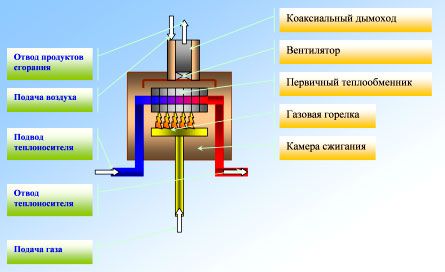

Convection gas boiler design
Gas convection heating boilers are installed for systems in which pipelines are provided. They do not provide heating of the air, but transfer the energy of gas combustion to the coolant - water in the pipes.
A feature of convection water heating is the use of an intermediate medium (heat carrier) for heating the air. In this case, the boiler drum is not a heat source. Therefore, the dimensions and weight of the structure are much less than those of Bulleryan ovens or similar ones.
The specifics of the organization of such a system are as follows:
- Mandatory installation of highways in all premises;
- Choice of models with 2 heat exchangers. One of them is intended for hot water supply;
- Registration of permits before connecting to the gas main.
However, the installation of such a boiler has a number of advantages. One of them is the duration of the autonomous operation of convector heating at home. In most cases, the control unit provides several modes, as well as the ability to connect to external temperature sensors for automatic regulation of the boiler power.
The cost of gas boilers is affected by their equipment. Models with a circulation pump and expansion tank have a higher price.
Convector heater safety
Particular attention should be paid to the safety of convector heaters. Despite the fact that convector heaters have pros and cons, the developers have made sure that safety always comes first.
- Each such equipment has frost protection. If the owners of the house are absent for a long time, then the temperature in the room with the help of convection equipment can be maintained for a long time, regardless of the temperature difference outside the room.
- There is overheating protection.


- Convection equipment has additional protection against moisture, so it can be used without any problems even in the bathroom.
Feedback on operational features
Electric convectors for heating a private house can have different sizes and power, it is these parameters that most often cause questions from consumers. For example, some customers do not know which convectors - high or low - are more efficient at work. Experienced consumers answer that the efficiency does not depend on the size, this parameter is influenced by the power. Form factors are created by the manufacturer for ease of installation of the device in a specific interior. The question may arise before you whether the convector is not dangerous when it is left unattended. Consumers note that such devices are completely safe. If the wiring can withstand the total power of simultaneously operating devices, then there is no need to worry.
Sometimes consumers are also faced with such a question, which is expressed in whether convectors can be used as the main source of heating. Everything will depend on the specific model and manufacturer's recommendations. In any case, the calculation of heating with electric convectors should be carried out according to the above formula. If you cannot decide whether to install such a device in a children's room, then you need to listen to the opinion of experienced users. They claim that on sale you can find models specially designed for children's rooms, they have a streamlined shape, a solid body and are devoid of sharp corners. If you want to choose the unit yourself, then you should prefer the one that has small holes so that the child cannot push anything into them.
